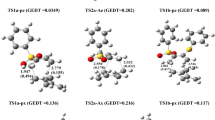Abstract
The dependence of the degree of charge transfer in substituted alkanes on the relative positions and electron-donor (or acceptor) properties of the groups eliminated in β-elimination reactions has been studied. Rules obtained from the generalized principle of maximum overlap have been used for the analysis of the relations between the coefficients in front of the basis functions in the expansions of the MOs. It has been established that trans elimination is observed in the case of substituents with pronounced electron-acceptor and electron-donor properties. In heterogeneous-catalytic reactions the nature of the active sites on the surface of the catalyst strongly influences the electron-donor (or acceptor) properties of the groups being eliminated. The catalytic dehydrochlorination of 1,1,2-trichloroethane has been considered as an example.
Similar content being viewed by others
Literature cited
C. K. Ingold, Structure and Mechanism in Organic Chemistry, Cornell Univ, Prsss, Ithaca (1953).
J. Mochida, J. Take, Y. Saito, and Y. Yoneda, “Linear free-energy relationships in heterogeneous catalysis. 6. Catalytic elimination reaction ef hydrogen chloride from chloreethanes on solid acids and bases,” J. Org. Chem., 32, No. 12, 3894–3898 (1967).
F. Weinhold and T. K. Brunk, “The principle of maximum overlap,” J. Am. Chem. Soc., 98, No. 13, 3745–3749 (1976).
A. J. Gordon and R. A. Ford, A Chemist's Companion: A Handbook of Practical Data, Techniques, and References, Wiley-Interscience, New York (1973).
M. J. S. Dawar, The Molecular Orbital Theory of Organic Chemistry, McGraw-Hill, New York (1969).
A. S. Davydov, Quantum Mechanics [in Russian], Fizmatgiz, Moscow (1963).
V. A. Gubanov, V. P. Zhukov, and A. O. Litinskii, Semiempirical Molecular-Orbital Methods in Quantum Chemistry [in Russian], Nauka, Moscow (1976).
Yu. A. Ustynyuk ed., Quantum-Chemical Methods for the Calculation of Molecules [in Russian], Khimiya, Moscow (1980).
D. Kost, H. B. Schlegel, D. J. Mitchell, and S. Wolfe, “Molecular orbitals from group orbitals. 9. The problem of hybrid lone pairs,” Can. J. Chem., 57, No. 6, 729–732 (1979).
P. Ya. Gokhberg, A. O. Litinskii, A. P. Khardin, et al., “Heterogeneous-catalytic dehydrochlorination of 1,1,2-trichloroethane. 1. Quantum-chemical investigation of the interaction of a reactant with acid and basic sites of a catalyst,” Kinet. Katal., 23, No. 1, 50–53 (1982).
Author information
Authors and Affiliations
Additional information
Translated from Teoreticheskaya i Éksperimental'naya Khimiya, Vol. 22, No. 2, pp. 168–174, March–April, 1986.
Rights and permissions
About this article
Cite this article
Shatkovskaya, D.B., Gineitite, V.L. & Bolotin, A.B. Application of the generalized principle of maximum overlap to the study of the stereochemistry of β-elimination reactions. Theor Exp Chem 22, 157–162 (1986). https://doi.org/10.1007/BF00519186
Received:
Issue Date:
DOI: https://doi.org/10.1007/BF00519186




